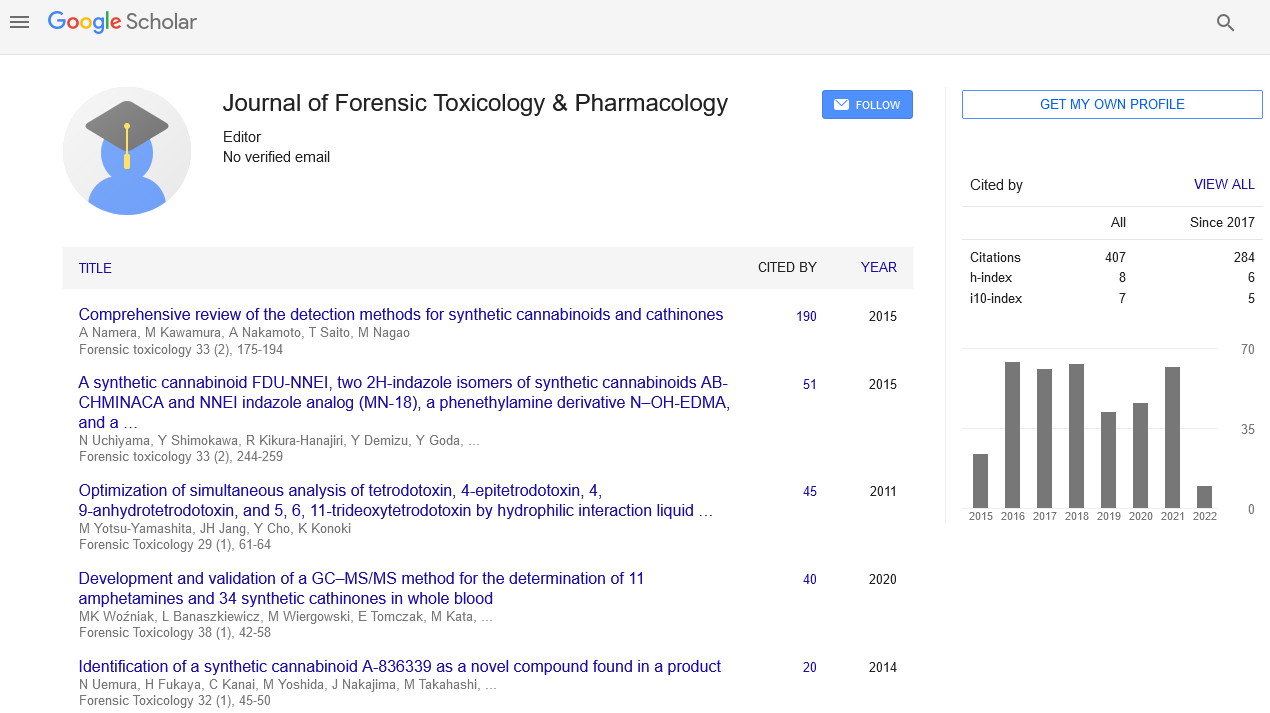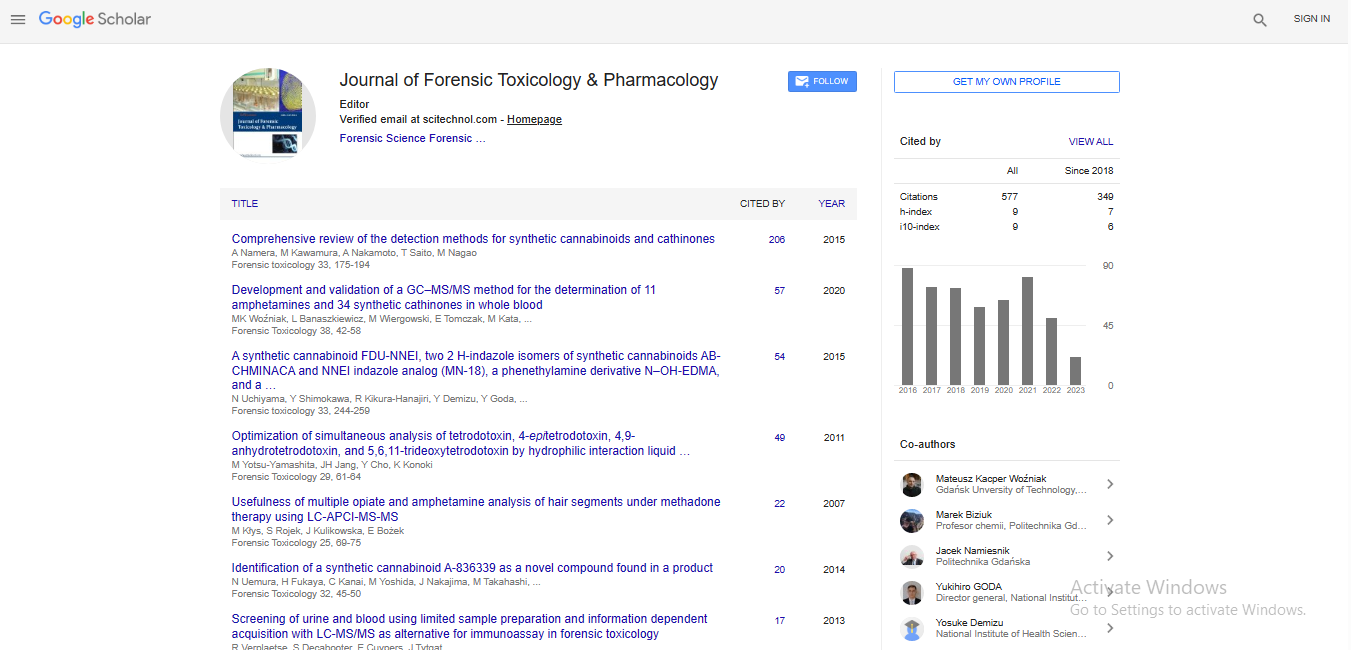Commentary, J Forensic Toxicol Pharmacol Vol: 13 Issue: 4
Metabolomics and Biomarker Discovery in Toxicology
Hamid Raleigh*
1Department of Pharmacological Sciences, Icahn School of Medicine at Mount Sinai, New York, USA
*Corresponding Author: Hamid Raleigh,
Department of Pharmacological
Sciences, Icahn School of Medicine at Mount Sinai, New York, USA
E-mail: raleighhamid@gmail.com
Received date: 26 November, 2024, Manuscript No. JFTP-24-156302;
Editor assigned date: 28 November, 2024, PreQC No. JFTP-24-156302 (PQ);
Reviewed date: 12 December, 2024, QC No JFTP-24-156302
Revised date: 19 December, 2024, Manuscript No. JFTP-24-156302 (R);
Published date: 26 December, 2024, DOI: 10.4172/JFTP.1000210.
Citation: Raleigh H (2024) Metabolomics and Biomarker Discovery in Toxicology. J Forensic Toxicol Pharmacol 13:4.
Description
Metabolomics, the comprehensive study of small molecules and metabolites in biological systems, has emerged as a transformative tool in toxicology. By providing analysis into biochemical pathways and physiological responses to toxic exposures, metabolomics facilitates the identification of biomarkers for early detection, risk assessment and therapeutic interventions. This innovative approach is reshaping the field of toxicology, bridging the gap between molecular mechanisms and clinical applications.
The human body produces a vast array of metabolites as intermediates and end products of metabolic processes. These metabolites reflect the dynamic interplay between genetic factors, environmental influences and lifestyle. Toxic substances, when introduced into this complex system, can disrupt metabolic pathways, leading to characteristic changes in the metabolome. Metabolomics captures these changes, offering a total assessment of the biochemical impact of toxicants.
Biomarker discovery is a foundation of metabolomics in toxicology. Biomarkers are measurable indicators of biological states or conditions, providing valuable information about exposure, effect and susceptibility to toxicants. For instance, exposure to organophosphate pesticides can alter specific lipid metabolites, which serve as biomarkers for neurotoxicity. Similarly, aromatic amines, commonly found in industrial environments, are linked to changes in urinary metabolites indicative of bladder cancer risk. By identifying these biomarkers, metabolomics enables precise monitoring of toxicant exposure and its health consequences.
One of the key strengths of metabolomics lies in its ability to detect subtle and early changes in biological systems. Traditional toxicological methods often focus on overt symptoms or end-stage outcomes, which may appear long after exposure. In contrast, metabolomics reveals early biomarkers that precede clinical manifestations, facilitating timely intervention. For example, earlystage liver toxicity due to drug-induced damage can be detected through alterations in bile acid metabolism, allowing for prompt adjustments in treatment protocols.
The application of metabolomics in toxicology extends to understanding inter-individual variability in response to toxicants. Genetic polymorphisms, age, diet and gut microbiota composition influence how individuals metabolize and respond to toxic substances. Metabolomic profiles capture these variations, offering personalized insights into toxicity risks. This personalized approach enhances the precision of risk assessments and therapeutic strategies, addressing the limitations of one-size-fits-all models.
Advanced analytical technologies confirm the success of metabolomics. High-Resolution Mass Spectrometry (HRMS) and Nuclear Magnetic Resonance (NMR) spectroscopy are the primary tools for metabolomic analysis. These techniques provide high sensitivity, specificity and reproducibility, enabling the identification and quantification of thousands of metabolites in complex biological samples. Coupled with bioinformatics and machine learning, metabolomics generates comprehensive datasets that resolve the multifaceted interactions between toxicants and biological systems.
Environmental toxicology is a prominent domain where metabolomics has demonstrated significant impact. Exposure to environmental pollutants, such as polycyclic aromatic hydrocarbons (PAHs) and heavy metals, leads to characteristic metabolomic signatures that inform regulatory policies and public health interventions. For example, metabolomic studies have identified biomarkers of oxidative stress and mitochondrial dysfunction in populations exposed to air pollution, signifying the need for stringent environmental controls.
Drug development and safety assessment also benefit from metabolomics. Adverse drug reactions and toxicity are major challenges in pharmaceutical research. Metabolomic profiling of preclinical models and clinical trials provides early indicators of druginduced toxicity, reducing the risk of unexpected adverse effects. This approach enhances the safety and efficacy of new therapeutics, streamlining the drug development pipeline. Metabolomics represents a paradigm shift in toxicology, offering unprecedented analysis into the molecular and systemic effects of toxicants. By identifying biomarkers, elucidating mechanisms and addressing individual variability, metabolomics enhances the precision and relevance of toxicological research. As technological advancements continue to refine metabolomic approaches, this field is poised to play a central role in safeguarding human health and advancing scientific understanding of toxicant-induced effects.
 Spanish
Spanish  Chinese
Chinese  Russian
Russian  German
German  French
French  Japanese
Japanese  Portuguese
Portuguese  Hindi
Hindi 
